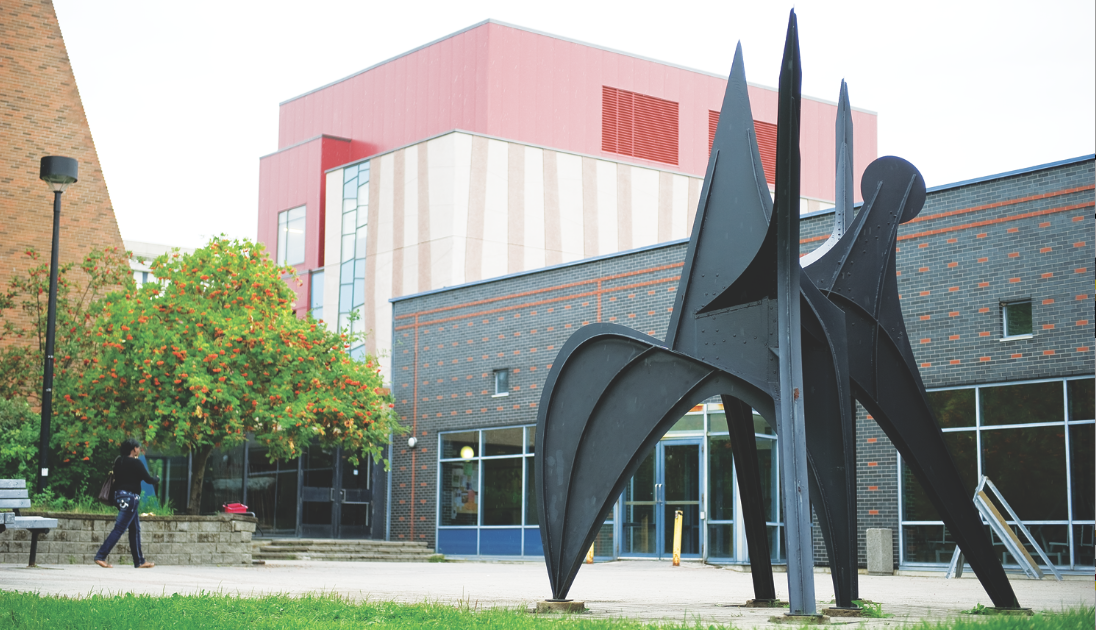Leslie Armstrong
Arts Editor
The Art Gallery of York University has been offering a guided outdoor tour of the school’s finest sculptures for many years now, running every Wednesday at noon from June until October. My knowledgeable AGYU tour guide, Allyson Adley, gave me context on some of the boldest, most ambitious sculptures on campus.
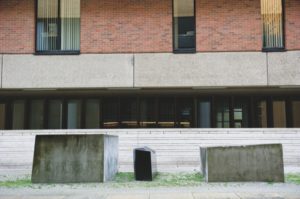
The tour started with a sculpture I didn’t know existed. Jocelyne Alloucherie’s minimalist Noire Solaire, Basse (1 – Left) sits between Vari Hall and the Behavioural Science building. It is a small slab of dark rock between two large concrete-like slabs, gently curved around the edges — the formation is meant to mimic the Canadian Shield, a geological rock formation.
Commissioned for this site, or “site specific,” Adley explains.
“The way Alloucherie works is very attuned, very aware, to the surrounding architecture and landscape.” Adley says the sculpture, like most from its time, takes on an “architectonic quality”.

She then explained the sculpture that gets the most head scratches: the long, tubular fountains with faces by the GO bus terminal (3 – Right). Enzo Cucchi, an Italian sculptor, sculpted the piece in 1993 shortly after his invitational residency here at York. The work pays tribute to Italian immigrants, and stylistically depicts a Madonna and child relationship. It is one of the few figurative, representational pieces on campus in that human faces are depicted in the vessels.

Mark DiSuvero’s zany, orange steel frame close to the Atkinson building, called Sticky Wicket (4 – Left), was built in 1978 using industrial materials, like steel beams, bent into shapes. The piece is meant to look more like a building skeleton more so than a sculpture, and, placed directly on the turf, invites the viewer to interact with it.
“See those hooks?” Adley asks, gesturing to the opposite side of the piece. “There was a swing at one point attached to the work.” But as one can imagine, the swing posed a safety hazard, and was promptly removed.
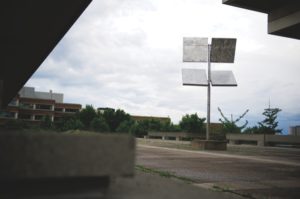
Four Squares in a Square (6 – Right), a mobile by George Rickey, sits atop the Ross building. It features four sheets of burnished steel hung from lead arms that, when blown in the wind, swing and reflect the sun’s rays beautifully.
“This is a piece that’s very much shaped by the elements. The time of year, the time of day, all of those things will impact our experience of the work. And so the work won’t be the same,” says Adley.
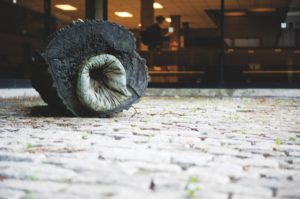
As it turns out, the wooden log in the Central Square courtyard isn’t actually a wooden log. Keep by Liz Magor (5 – Left) is a bronze casting of a log, produced in the Odette sculpture studio on campus, with a silicon casting of a sleeping bag lodged down the middle. A big theme that pervades Magor’s work is refuge and hideout in the woods, which, for her, seems to encapsulate a previous era.
“She’s interested in this idea of a kind of contemporary person wanting to relive or pretend to be living at a different historical time,” explains Adley. “It’s a metaphor for escaping one’s own contemporary reality.”
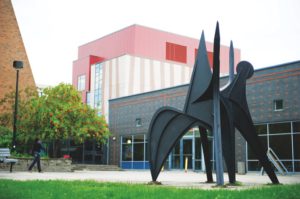
The pièce de résistance of the tour is Model for Man by Alexander Calder, which stands behind the Fine (2 – Right) Arts building. Calder, originally a mobile artist like George Rickey of Four Squares in a Square, was so used to producing mobiles that he called anything that didn’t move a “stabile”. Although the piece is fairly abstract, there remains some representation of a male anatomy.
“But what I want to draw your attention to is not only the sculpture, but also the shadow cast by the sculpture, which is pretty amazing as well,” shares Adley.
It’s almost as if the representation of human form is more discernable in the shadow cast than by the sculpture itself.
As students, we’ve walked past these sculptures and squinted up at them thousands of times, but the real beauty of these pieces lies in the context in which they were made. These avant-garde works reflect a sophisticated arts community at York, so it is important that we understand their significance. Now, students of York, we know what we need to do: we need to re-attach that swing back on the Sticky Wicket.

A story for every statue
